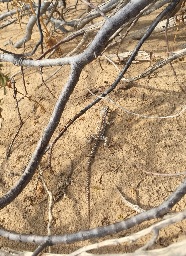Colorado Desert Fringe-Toed Lizard (Uma notata)
Description: 2 3/4 to 4 4/5 inches long from snout to vent. A medium-sized, flat-bodied, smooth-skinned lizard that inhabits areas of loose sand. Color is white, with a contrasting pattern of broken black lengthwise lines and round, eye-like spots. The color and pattern create a successful camouflage which allows a lizard to blend into its sandy habitat. The underside is pale with black bars on the underside of the tail, a conspicuous black bar or spot on the sides of the belly, and dark diagonal lines on the throat. The sides of the belly have a permanent (not just during breeding) orange or pinkish stripe, which intensifies during the breeding season. Males have two enlarged post-anal scales.
Habitat: The Colorado Desert fringe-toed lizard (Uma notata) occupy the vast windblown sands of the Algodones Dunes in Imperial County, California and crossing the border into Sonora, Mexico.
Range: The range includes southeastern California in the United States, and northeastern Baja California in Mexico. Its populations are discontinuously distributed across disjunct patches of suitable habitat. In Mexico it ranges south from the United States border to the western edge of the Sierra los Cucapás. There is a disjunct subpopulation further south on the northern edge of the Sierra las Pintas. The species might also occur on the eastern slopes of the Sierra Juárez. Its elevational range extends from below sea level at the edge of the Salton Sea to around 600 feet northeast of Borrego Springs in San Diego County, California.
Found in these States:
AZ |
CA
Diet: Eats primarily small invertebrates such as ants, beetles, and grasshoppers, along with occasional blossoms, leaves, and seeds. The consumption of plant material may inadvertently occur when a lizard is eating insects. Adults will also eat lizard hatchlings.
Reproduction: Mating begins in May. 1 - 5 eggs are laid from May to August. Multiple clutches are laid in favorable years. Incubation lasts around 60 days.
Status: Listed as Near Threatened because its extent of occurrence is probably not much greater than 20,000 km˛, and the extent and quality of its habitat are probably declining, thus making the species close to qualifying for Vulnerable under Criterion B1ab.
»» Kingdom: Animalia - Animals
»» Phylum: Chordata - Chordates
»» Subphylum: Vertebrata - Vertebrates
»» Class: Reptilia - Reptiles
»» Order: Squamata - Lizards
»» Family: Phrynosomatidae - North American Spiny Lizards
»» Genus: Uma
»» Species: Uma notata - Colorado Desert Fringe-Toed Lizard
»» Subspecies: None
This article uses material from the Wikipedia article "Colorado Desert Fringe-Toed Lizard", which is released under the Creative Commons Attribution-Share-Alike License 3.0. Content may have been omitted from the original, but no content has been changed or extended.
|








